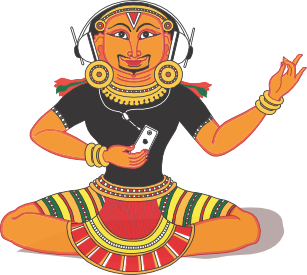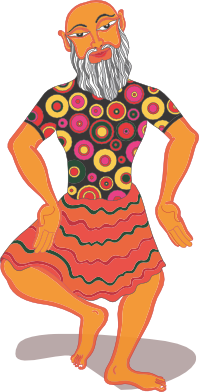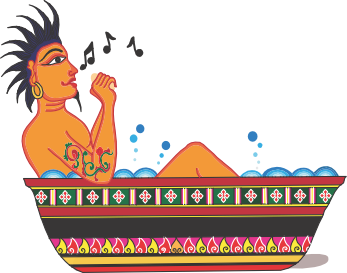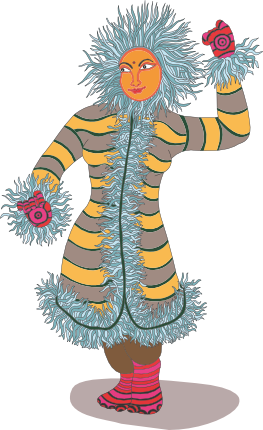The first, second and third Thirumurai (also called the Panniru Thirumurai) which is a compilation of various Tamil poems in praise of Lord Shiva,were composed by Sambandhar, which includes his popular work – Thirukadaikkappu. Sambandhar in a short life span of 16 years, was one of the architects of the Bhakthi movement. In addition to his delightful songs, he defeated the Jain monks in debate and succeeded in bringing the hunch backed PAndya King back into the Hindu fold. He has composed 1600 pathikams, out of which only 384 are now available
Dr.K.R.SeethaLakshmi, Professor, Department of Music, Queen Mary’s College in her article speaks of the compositions of Sambandhar – “In the place called Thirukolakka, the Supreme Mother blessed him with “Golden Cymbals” (Thiru Taalam), which testifies for his mastery over the metrical “Saahithyam” (Thevara Hymns). Chekkizhaar, the author of “Periya Puranam” quotes that Gnana Samabandar composed multi faceted rhythmic aspects in his hymns – “Senthamizh maalai Vigarpa ….. Panninar Gnanasambandar”.
The time measures that are still prevailing at present, are all found in Gnana Sambandar’s Thevaram. It is an evident fact that the Thevara Padigams are metrical and the time measures were introduced according to the Kattalai.
Gnana Sambandar has contributed a lot to the realm of time measures in Tamil Music. The popular taalas of Thevaram are Roopaka, Triputa, Mattya, Jhampa, Chaapu, Ata and Anga tala. The taala is determined with the help of Kattalai. The first composition of Gnana Sambandar “Thodudaiya Seviyan” is set to be in Roopaka taala of the first Kattalai. Below are a few of his compositions that speaks for itself the variety of taala structures he has adopted for his hymns.
1. Thodudaiya Seviyan – Roopaka
2.Neeru Servador – Chatusra Jathi Triputa
3.Chirai Aarum – Thisra Jathi Triputa
4.Maadhar madappidiyum – Rupakam(Yaazhmuri Pann)
5. Manninaervizhi Maadharaar – Misra Chapu
6. Marundavai Mandiram – Anga Talam
7.Vaanavargal Thaanavargal – Kanda Chapu
The “Thirutaala Jathi” of Gnanasambandar, was poured out of ecstasy with Chandam – a metrical aspect of Kattalai and other rhetorical beauties that adorns them. In this particular Padigam(Hymns) the numbers – Ondre, Irande, Moondre, Yezhae also confirms the prosodic beauty of his compositions. It signifies that the Padigam is set in the pattern of “Pari Padal” where the intricate time measures are aplenty. The rhythmic structures thaka-takita- thaka dimi etc are concurrently established in a single phrase and it would be visualized in the Paripadal song No. 30 “Thenul Theral Nee”.
The Thirutaala Jathi studded with the rhythmic aspects were highlighted by the divine composer Sri Sundaramurthy Swamigal in the padigam No. 642 “Naalum Innisaiyal” . Sambandar himself records that his compositions are with Chandam by the following:
a)Chandaiyal Tamil… – Namasivaya Padigam
b)Chandamar Chentamil – Song No. 305
c)Seerinmali Chentamil – Song No. 333
d)Kalikovaial Chandame – Song No. 126
The Thirutaala Jathi Padigam connotes that the tala structure can be fractionally divided according to the formation of the song. The first line of the composition is taken
e)Bandaththal ….. – 5 takita thaam
f) Vandeppal….. – 6 taka taa taa
g) Payindru Nindra – 7 takita taa taa
h) Umber Appaale – 8 takita taka takita
i)Servar Yenorkaan – 9 takita taka dimi taa
j)Payil gana munivargaluum – 10 taka dimi taka thaam taka
“Bandaththal” can also be rendered in Tisra-Chatusra-Kanta-Misra-Sankirna Nada.
The layas structure of the above padigam portrays that there is an apparent and actual rhythm that glorifies. ” (Dr.K.R.SeethaLakshmi)

2) Appar also known as Thirunavukkarasar was a Saivite poet born as Marulnikkiyar in Thiruvamur. He was one of the 63 NAyanars of the 8th C.C.E. His parents died when he was young child, and he stayed with his sister Tilakavathiyar for some time. Then he joined a Jain monastery, where he earned the title Dharmasenar. He returned home to his sister after acquiring a disease. He and his sister prayed fervently at the Shiva Temple in their town. When he was cured, he began singing in praise of Lord Shiva in verses which later came to be called thevAram. He met Sambandhar as he traveled around, and they sang verses together from temple to temple. It was Sambandhar who began calling him Appar, out of respect, and he is known most famously by this name. The fourth, fifth and sixth Thirumurai were authored by ThirunAvukkarasar , He spent his long span of 80 years in social service. Out of the 4800 pathikams (group of 10 stanzas) he wrote, only 312 are available. Though most of his thevAram verses were set to metres, some were set to melodic modes of historic Tamil music, called Panns.

3) Sundarar also known as Sundaramurthi NAyanar, was one of the other 63 NAyanars. He was a child prodigy who also wrote many Shaiva Bhakthi poems. His works, called Tirupaatu, are also included in the seventh Thirumurai. Sundarar was born to a couple, who were both NAyanars themselves, but was later adopted and raised by the local king, because the king was enamored by the little boy. It is said that Sundarar was about to be married when an old man interrupted the wedding and asked Sundarar to be his servant and follower, but Sundarar, not seeing who the man really was, addressed him a mad man. The old man resumed his usual form as Lord Shiva and asked Sundarar to begin a verse addressing him as the mad man. Sundarar is known to have married twice and desired rebirth to stay with them, so Lord Shiva temporarily blinded Sundarar. One legend affirmed that when he was in Tiruvarur, he named all the future Nayanars through the Tirutthondar-Tohai . After going on a pilgrimage with the king of Kerala, he was taken up on a white elephant up to heaven. Only 100 pathikams of Sundarar are available The Periya Puranam which is included in the Thirumurai describes Sundarar’s life story.
Moovar’s compositions compared :
The first 7 ThirumuRai are collectively known as ThEvAram, garland of gods Sambandar was a little boy. Sundarar, a youth in his twenties and Appar of ripe age. Their songs show perspectives appropriate to their age,Sambandar’s songs has more description of buildings, nature, flora and fuana etc.. Little boys get exited when they see monkeys atop trees and fishes in the floods. – madaiyil vaLai paaya matharaar….. and .. sila manthi alamanthu maramEri mugil paarkkum thiruvaiyaarE… Sundarar’s song – we can see some humour and mischief, typical of any youth in their twenties. — vALankirupar thiruvArooriR vazhnthu pOtheerE…Appar’s songs are serious, filled with devotion, emphasis on values, militancy, courage etc. – What more from an old man. — ‘en kadan pani seithu kidapathe….’ and ‘naamaarkkum kudiallOm…”

4) Maanikkavaasagar was born in Vadhavoora, and came after Sambandar, Appar, and Sundarar. He contributed to the restoration of temples and faith. One legend states that a Pandiyan king entrusted Maanikkavaasagar with a lot of money to purchase horses for a coming battle. On the way there, he stopped and saw an old temple which needed restoration more than the king needed horses, so he renovated and rebuilt the temple in full glory. The king put him in jail for misappropriation of funds, but Lord Shiva, who was pleased by Maanikkavaasagar’s faith, released him and taught the king a lesson on having faith. Maanikkavaasagar traveled many places and sang devotional verses called Thiruvaasakam. He also wrote the Thirukkovaiyar, and both texts are included in the Thirumurai. His compositions thiruvembAvai are also popular (MoyyAr TaDam Poygai for eg)He settled in Chidambaram and died soon after.





